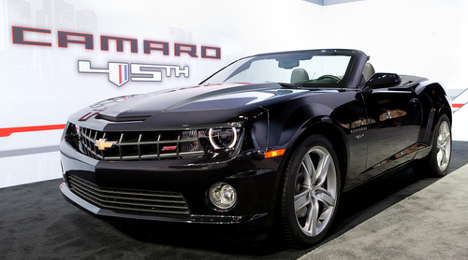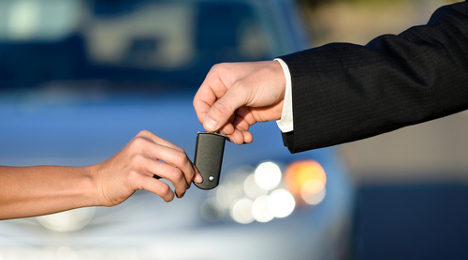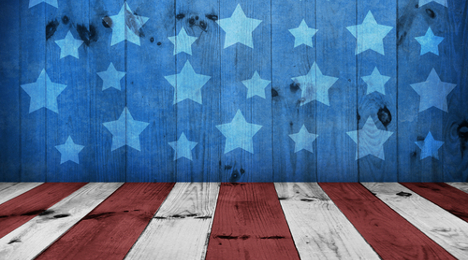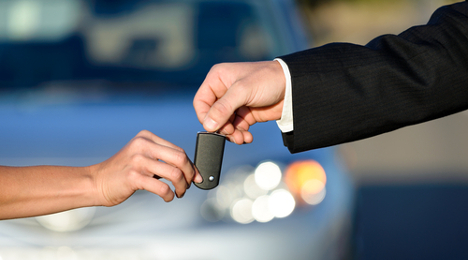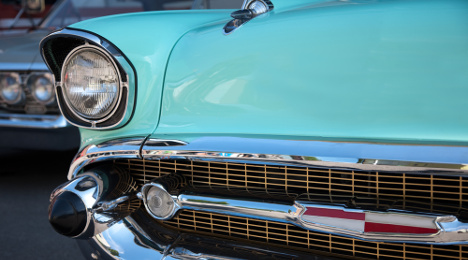It appears as though Independence Day weekend is the ideal time to target the summer whims of convertible lovers.
That’s according to an analysis from NADA Used Car Guide released Thursday, which highlighted a few manufacturer financing incentives that should prove particularly appealing to July 4 shoppers who enjoy the top-down side of life.
“If horsepower and performance are on their requirement list, shoppers might consider 72 months of zero percent financing on Chevrolet’s Camaro,” said Larry Dixon of NADA Used Car Guide. “Paying nothing in interest over the life of a loan helps you reach a positive equity position sooner.”
NADA Used Car Guide’s executive analyst Jonathan Banks added: “If your taste in vehicles changes often and you don’t want to put any money down on a purchase, Mazda is leasing their MX-5 (Miata) roadster for 24 months with nothing down.”
Here are a few other top-down suggestions from NADA Used Car Guide:
- MINI Cooper S Convertible or Cooper S Roadster – 1.9 percent APR for 36 months from MINI Financial Services, with no payments for up to 90 days.
- Volkswagen Beetle Convertible – 0.9 percent APR for 60 months.
For a list of solid convertible options for both new- and used-vehicle shoppers, check out the organization’s Perspective: New and Used Convertibles for Under $35,000 here.
Dealers should expect a sharp increase in late-model used-vehicle supplies along with significant decreases in used-vehicle values over the next couple of years.
That’s according to the National Automobile Dealers Association, which hosted its Economic Quarterly press briefing on Monday to recap the first half of the year and set its gaze forward.
The NADA’s current forecast estimates that the supply of late-model vehicles, which it specifies as zero- to 5-year-old vehicles, will be 28 percent higher by 2017 than at the end of 2014.
The association’s projection, based on the expectation of increased used-vehicle supply and pressure from new-vehicle sales, would result in a 4.5-percent decrease in used-vehicle prices per year in 2016 and 2017.
Larry Dixon, senior manager of market intelligence for NADA Used Car Guide, said that used-vehicle prices have remained relatively stable up until now despite the ever-present pressure from new-vehicle sales and increased supply of late-model vehicles. He expects the decline in used prices to be relatively tame for the rest of the year.
“NADA forecasted a slight decline of 0.3 percent for used prices of vehicles up to 8 years in age through the first half of 2015, so the year’s result so far has essentially played out as we have expected,” Dixon said. “We expect used-vehicle prices to decline by 2 percent over the second half of 2015 compared to levels recorded year-to-date.”
These comments followed NADA chief economist Steven Szakaly’s review of the new-vehicle industry. On that front, NADA increased its sales expectations for 2015 from 16.94 million to 17.17 million units. Szakaly expects 2016’s results to be a peak; he forecasts a total of 17.62 million new cars and light trucks will be sold next year.
“Purchases and leases of new cars and light trucks will continue as a stronger overall economy continues to drive demand,” Szakaly said. “While we’ve had a slower-than-normal recovery from this recession, we are seeing the sixth consecutive year of new light vehicle sales growth.”
After quite a strong May for used-vehicle sales (at least among franchised dealers), how is June shaping up? That’s the question a couple industry observers are looking at as the month winds down.
Edmunds.com is estimating June used-car sales (across all channels: franchised and independent dealers, plus private-party figures) will reach 2.98 million. This would result in a used SAAR of 37.2 million; last month, Edmunds pinpointed used sales at 3.07 million with a SAAR of 37.4 million.
Next up, TrueCar forecasts that there may be more than 3.33 million used-vehicles sold in June, which would beat year-ago figures by 8.4 percent.
As for May, the National Automobile Dealers Association announced earlier this month that there were roughly 4.02 million units, compared to an even 4 million in May 2014.
This brought the year’s tally just past 14 million used cars and light trucks, putting 2015’s pace thus far just slightly behind 2014’s, where total used sales passed 14.1 million units by the end of May 2014.
“Private-party sales of used vehicles have declined this year,” Steven Szakaly, NADA’s chief economist, said when the report was released. “The cold winter combined with a wetter than usual spring dampened sales by individuals. New-car dealers, on the other hand, clearly benefitted from the increase consumer traffic during Memorial Day sales events that brought new car buyers in to shop for both new and used vehicles.”
To put that in perspective, new-vehicle dealers sold 1.52 million used units in May, a 3.6 percent increase year-over-year, while used-car dealers and private-party sales each declined 1.6 percent, respectively, compared to 2014.
Used-vehicle dealers sold 1.29 million vehicles in May; private parties sold 1.21 million units for the same month.
Editor's Note: Staff Writer Josh Hyatt contributed to this report.
In the hopes of helping dealers prepare for the anticipated surge of sales for the holiday weekend, the team at DealerSocket assembled data from last year’s Memorial Day activity to help give dealers a better idea of what to expect this year, including the kind of profits they may see in their used-car operations.
Here’s an overview of some of the statistics, created from DealerSocket's insights into the data from 950 of it's dealer customers, to help dealers gain some perspective of their own on potential areas of focus for the upcoming Memorial Day holiday as well as shed some light on last year's used-vehicle sales successes.
Used Vehicles Made More Money
- The average total profit from used vehicles, versus new vehicles, was higher for Memorial Day 2014.
- New-vehicle average: $1,360
- Used-vehicle average: $2,152
- More shoppers made test-drive appointments for used cars.
- Appointments set from new-car leads: 20 percent
- Appointments set from used-car leads: 35 percent
- The percentages for appointment confirmations, show rates and sell rates were nearly identical for used and new vehicles.
- Appointment confirmation rates: 54 percent for new, 53 percent for used
- Appointment show rates: 66 percent for new, 64 percent for used
- Sales from appointments: 19 percent for both new and used
Cleaning Up Your Phone Operations
- Have a good inbound phone process: 89 percent of phone leads yielded a scheduled appointment. DealerSocket recommends always asking for an appointment — it can’t hurt to ask.
- On average, it took one more follow-up call to close a used-vehicle sale versus a new sale.
- Average number of outbound calls for new: 1.8.
- Average number of outbound calls for used: 2.6.
Last Year, Economy Cars Were King
- Economy cars (new and used combined) had some of the highest close rates from new leads for Memorial Day 2014.
- Scion: 66 percent close rate
- Fiat: 56 percent
- Mini: 53 percent
- Hyundai: 50 percent
The Floor Made the Most Money
- Average total profit, for both used and new sales, by lead sources:
- Floor: $1,810
- DealerSocket’s RevenueRadar: $1,674
- Phone: $1,622
- Internet: $1,401
More information about DealerSocket’s offerings can be found it the company’s website.
The same economic drivers helping to lift the new-car market are also benefitting the used-car market, said NADA chief economist Steven Szakaly, whose analysis points out three key metrics pushing demand.
“Just like the new-vehicle market, we continue to see healthy demand for used cars,” Szakaly said in an analysis released by the National Automobile Dealers Association last week.
“Those same factors in the new-vehicle market, which include low financing rates, extra spending money and improving employment opportunities, are driving car buyers to the used-vehicle market as well,” he added.
With retail demand churning along, trade-in values remain high, as well, according to Szakaly.
As for the most recently completed month in the used-car market, projections from industry analysts early last week were pointing to used-car sales for April to finish north of 3 million units.
Edmunds.com called for approximately 3.2 million used-car sales for the month.
Although this would be down from the 3.5 million used sales in March, the resulting used SAAR for April (36.7 million) would edge out March’s pace of 36.1 million.
Meanwhile, TrueCar projected used sales in the neighborhood of 3.07 million vehicles, which would be even with last April.
Based on projections from industry analysts released Monday, expect used-car sales for April to finish north of 3 million units.
Edmunds.com is calling for approximately 3.2 million used-car sales for the month. Although this would be down from the 3.5 million used sales in March, the resulting used SAAR for April (36.7 million) would edge out March’s pace of 36.1 million.
Meanwhile, TrueCar is calling for used sales in the neighborhood of 3.07 million vehicles this month, which would be even with last April.
On the new-car side, Kelley Blue Book is calling for 1.46 million sales this month (including fleet sales), which would be the best April in a decade. The resulting SAAR would be 16.5 million. KBB is calling for a full-year new-car sales total of 16.9 million, which would be the strongest year since 2005.
“While April won’t bring too many surprises, sales should continue to grow at a steady pace,” said Alec Gutierrez, senior analyst for Kelley Blue Book. “Retail sales continue to be strong which continues to keep the overall sales outlook healthy. There is restrained incentive spending and steadily rising transaction prices, which are both good signs for the industry.”
Edmunds predicts 1.46 million new sales (also including fleet), for a 16.7 million SAAR. That total would be down 5.1 percent from March figures but up 5.5 percent from April 2014 numbers.
“It is very common for April sales to be slower than March, which typically gets a boost from certain automakers who offer great deals to motivate shoppers as the companies close their fiscal year,” says Edmunds.com senior analyst Jessica Caldwell. “In fact, we often think of April as ‘the calm before the summer storm.’ It won’t be long before the summer selldown of the outgoing model year vehicles, which always draws lots of foot traffic through dealerships.”
TrueCar has the number pegged at 1.475 million for the month (including fleet). Its SAAR projection of 16.8 million for April would be the strongest for April in 10 years.
“Underpinning this solid outlook is an incredible appetite for crossovers, sport utilities and pickup trucks,” said Eric Lyman, vice president of industry insights for TrueCar. “Automakers with strong light truck offerings continue to gain and will benefit from the likelihood gasoline prices will remain low this summer.”
The forecast from J.D. Power and LMC Automotive reflects a similar optimism as others.
It is projecting total new-car sales (including fleet) to reach 1.46 million and represent the best April in 10 years, with the month’s SAAR at 16.6 million.
LMC has kept its full-year forecast at 17.0 million units. However, it has trimmed its retail predictions from 14.0 million to 13.9 million, given modest gains in fleet sales.
“Overall, auto sales remain strong, a trend that is sustainable throughout 2015 due to consumer demand that is being fueled by 50 new or redesigned models in showrooms this year,” said Jeff Schuster, senior vice president of forecasting at LMC Automotive. “High year-over-year growth will become more challenging over the next few months, but a slip in the growth rates doesn't change the underlying positive trend.”
There were three primary factors behind what KeyBanc Capital Markets believes to be a rosy outlook for earnings growth in the retail car business over the next couple of years: strong used-car sales, strong parts and service sales and the current dealership acquisition trends.
Based on analysis provided in KeyBanc’s report from its most recent dealer survey, Auto Remarketing will take a look at each of these areas individually, starting with used-car sales.
“Industry used-vehicle growth outlook in the low to mid-single digits is intact, and we believe franchised dealers should outperform the overall industry,” KeyBanc said in the section of the report delving into the 2015/2016 longer-term forecast.
Shedding more light on this expected used-car growth, KeyBanc first points to some economic-based factors, including:
— An economy expected to climb at a 2.5-percent to 3.5 percent clip each year
— Decreasing unemployment
— KeyBanc projects continued strength in available financing, highlighted by Experian data for the fourth-quarter indicating flat delinquency movement from Q4 2013 and across-the-credit-spectrum gains in financing.
Not to mention, dealers should be buoyed by increasing used-car supply. It is predicted there will be around 20-percent annual growth in off-lease volumes for “the foreseeable future,” giving late-model inventories a nice bump.
“This is positive for all used-vehicle sales, but zero- to 4-year-old cars should outperform,” the company said in the report. “Franchised dealers under our coverage have the potential to outperform the overall used-vehicle industry and grow used-vehicle sales as high as low double-digits, as they have the first hand pick at this highly desirable low-mileage off-lease inventory.”
(Overall, franchised dealers have enjoyed a steady rise in retail used-vehicle sales the past four years, according to the NADA Data 2014 report. And retail selling prices for these dealers have climbed from about $15,000 in 2009 to roughly $19,000 in 2014, NADA indicated.)
A Manheim Consulting graph included in KeyBanc’s analysis shows off-lease volumes potentially reaching 2.5 million units in 2015 (compared to just over 2 million in 2014) and hitting the 3.0 million mark in 2016.
And although the increases in new-lease originations aren’t predicted to be as dramatic as those that occurred between 2009 and 2013, the Manheim data set projects 2016 will be the fourth consecutive year with more than 3 million leases written.
March, Q1 & Beyond
Eighty percent of respondents in KeyBanc’s survey said their used-vehicle sales increased year-over-year in March. Although a month earlier, 83 percent had reported used sales falling, the first quarter overall appeared to be rather strong in the used-car department.
“For the full quarter, we expect year-over-year growth in the mid-single digits or higher on average in the industry,” KeyBanc said in the report.
As for full-year 2015, TrueCar said earlier this week it is expecting the industry to reach 2.61 million certified pre-owned sales and 35.79 million non-CPO used sales this year. These would represent year-over-year increases of 11.4 percent and 3.3 percent, respectively.
TrueCar forecasts the supply pool of used vehicles from ages 1 to 5 will come in at 10.4 million this year.
“Improved inventory means we can expect a stellar year for the used market — and particularly for certified pre-owned vehicles,” said Larry Dominique, TrueCar's executive vice president and president of ALG, TrueCar's residual value data unit.
“Across the industry automakers have enhanced CPO programs to delight buyers with longer warranties, improve their own residual values, and successfully grow volumes of these high-margin products for their dealers,” he added.
Auctions and dealerships that have a strong business interest in how classic cars are moving on the wholesale and retail fronts should be pleased to hear the upbeat projections from IBISWorld, which said the industry appears “to be back on the right track.”
The firm’s latest report showed that revenue is estimated to increase during the next five years, including a “robust” jump this year.
“Classic cars are highly discretionary purchases; therefore, demand for the industry is extremely elastic among most U.S. consumers and depends on prevailing levels of per capita disposable income,” IBISWorld economic analyst Nick Petrillo said.
When per capita disposable income levels fell and investor uncertainty increased during the recession, Petrillo explained that fewer consumers purchased classic and antique cars.
“Although per capita disposable income has gradually returned from its historic lows, many middle-class consumers have yet to resume purchases of industry vehicles due to depleted savings and relative disinterest in spending money on such high-priced assets,” Petrillo said.
With the economic recovery likely to yield greater purchases on classic cars from both wealthy investors and the general public, IBISWorld anticipates industry revenue to steadily grow over the five years to 2020.
Analysts projected demand for classic cars of all makes and models is anticipated to grow, although budget classics and American muscle cars are most poised for growth.
The IBISWorld report also highlighted dealers will benefit from higher demand for classic cars, which will likely push up auction prices on many of the industry’s most popular models.
“Higher auction prices will ultimately boost industry profit margins over the next five years as a result,” Petrillo said.
Nevertheless, Petrillo acknowledged long-term industry growth prospects will be limited by external competition from many individuals throughout the United States who own and sell classic cars amongst themselves.
“Independent sales of automobiles are extremely common and represent an increasing threat to the industry, particularly as consumers gradually increase their use of online classifieds to advertise their automobiles to a national audience,” Petrillo said.
“New-car dealers will also represent a major source of competition for industry dealers as major manufacturers have begun a trend of modernizing classic models and retailing them as modern, state-of-the-art collectibles,” he went on to say.
If your store isn’t already moving metal at a steady clip, perhaps the results of the newest DrivingSales analysis should be uplifting since it includes a projection of sales growing by as much as 24 percent if the retail experience improves.
The DrivingSales Consumer Experience Study uncovered what orchestrators called “profound” changes in consumer expectations, driven by their experiences in other retail sectors, that up-end the current conventional wisdom in dealerships on marketing and sales best practices.
The study also identified how the expectation gap between dealers and consumers has grown to such a level that a fundamental change in the consumer experience is required if dealerships expect to remain competitive during the next five to 10 years.
A selection from the hundreds of insights collected include:
• Ninety nine of 100 automotive shoppers begin their purchase journey expecting it to be a “hassle” driven in large part by their experience, and that of friends/family, with retailers seeking to control the buying process to the retailer’s objectives.
• Shoppers are exposed to dozens of conflicting influences making them wary and distrustful, driving them to seek what they perceive as objective information from trusted sources — primarily trusted friends and family and independent third-party sites
• Shoppers are keeping dealers and salespeople at a “proverbial arm’s length” until late in the purchase process. When they’re ready to interact, 61 percent initiate contact by walking into the dealership without prior contact.
• This distrust puts the consumer on a hair trigger as they engage with the dealer
• 50 percent will walk out of a dealership if the dealer requires a test drive before providing a price; 43 percent if personal information is required.
• 56 percent of shoppers said they would buy more often if the dealership process was not so difficult; the impact of this retail aversion was quantified at a potential increase in sales volume of 24 percent.
The study is based on a 16 month-long ethnographic and quantitative research initiative with more than 1,300 shoppers and buyers. The project also looked at the rational and emotional factors that cause modern shoppers to connect, or disconnect, with dealers in the buying process.
“Yesterday’s formula for automotive retail success is deterring consumers and suppressing sales volume. Our research shows the key to sales success today is building trust through an open and transparent customer experience at every stage of their buying process,” said Jared Hamilton, founder and chief executive officer of DrivingSales.
“Our findings are a clarion call for change in how cars are retailed and provide practical guidance to retailers and manufacturers on how to bridge this customer expectation gap and advance the industry,” Hamilton continued.
Hamilton will be revealing a summary of the results of this research in his keynote address at the DrivingSales President’s Club event at the New York Grand Hyatt on Wednesday.
Additional findings and recommendations from the full research study will be shared with the industry over the coming months. They will include recommended changes to dealership marketing and sales processes and insights into specific segments of buyers.
Interested parties can keep connected with these findings at drivingsales.com/trust.
“Some advanced dealers and groups have already seen and acted upon many of the trends uncovered by this research,” company officials said. “As part of this multi-year research initiative, DrivingSales will continue to research evolving automotive retail practices and share results achieved.”
Representatives from the National Automobile Dealers Association hosted its quarterly economic press briefing on Monday to set the scene for Tuesday's NADA / J.D. Power Automotive Forum.
And the tone set by NADA for the remainder of the year and coming years was remarkably positive. Perhaps one of the strongest examples of that attitude was portrayed by Jonathan Banks, the association’s executive analyst, who, when asked when the impending “used-car bubble” that some in the industry have been forecasting for years was going to bust, said it doesn’t currently exist.
“NADA was never one of the pessimists that thought there was a used-car bubble,” Banks said. “In fact, if you just look at the used supply, used supply in ’14 was flat compared to ’13, and before that it was actually declining, obviously because of the pull-back in new vehicle sales from the recession. But this year will be the first year since the recession that we’re actually going to see a little bit of growth.”
Auto Remarketing previously reported on the NADA’s prediction that used-vehicle supply will return to pre-recession levels in 2017. According to Banks, the industry should expect to see the strongest burgeoning in used supply in 2016 to 2018, with a predicted growth of 3.5 percent of zero- to 8-year-old vehicles in 2016 and as much as 4.5 percent in 2017. He didn’t want dealers to worry, however, too much about large jumps in pricing levels.
“We’re going to see some moderation in used-vehicle prices, but we think it’s going to be slow,” Banks said. “We don’t think that there’s any indication that there’s any sort of bubble. It’s just purely supply and demand that’s been keeping the prices strong.”
Banks did warn about the pressure that the new-vehicle market may put on the used industry in coming years. According to the executive analyst, the current slowing of new-vehicle sales is seen as a potential “headwind” for the used market, which could see an increase in manufacturer incentives, in an attempt to continue new-vehicle sales pace, make the option of a used vehicle less and less enticing for the budget-minded consumer base.
NADA expects to see a decline in price on zero- to 8-year-old vehicles by as much as 1.5 percent this year, which is down from the 2 to 2.5 percent the association forecasted in January.
“Our forecast of down 1.5 percent, in a historical perspective, still puts used prices very high,” Banks continued. “But what we do know, what we definitively know, is those late-model used vehicles, that supply coming back, will continue to grow.”
Alongside Banks was Steven Szakaly, NADA’s chief economist. Some highlights from his breakdown of the economic outlook for the market, on the new-vehicle side, are as follows.
- Despite a “somewhat weak” first quarter (due to weather and the West Coast port strike), NADA still predicts sales of 16.94 million units in 2015.
- GDP growth in the first quarter was 2.1 percent. NADA expects an overall annual growth for the year around 2.9 percent, down from previous prediction of 3.1 percent.
- Light trucks will make up 56 percent of overall light-vehicle market, up several percent over last year.
- Segments most impacted by lowering oil prices will be remain to be light cars – which will not change this year. Expect to see slight hits on hybrids and electric vehicles, as well.
- Light vehicle sales will outpace the overall economic growth for what will be the sixth year in a row.
- NADA is worried about wages and income: It would like to see growth between 1.5 and 2 percent in 2015. If that doesn’t happen, it could lead to negative outlooks for the end of 2015 and the rest of 2016.

